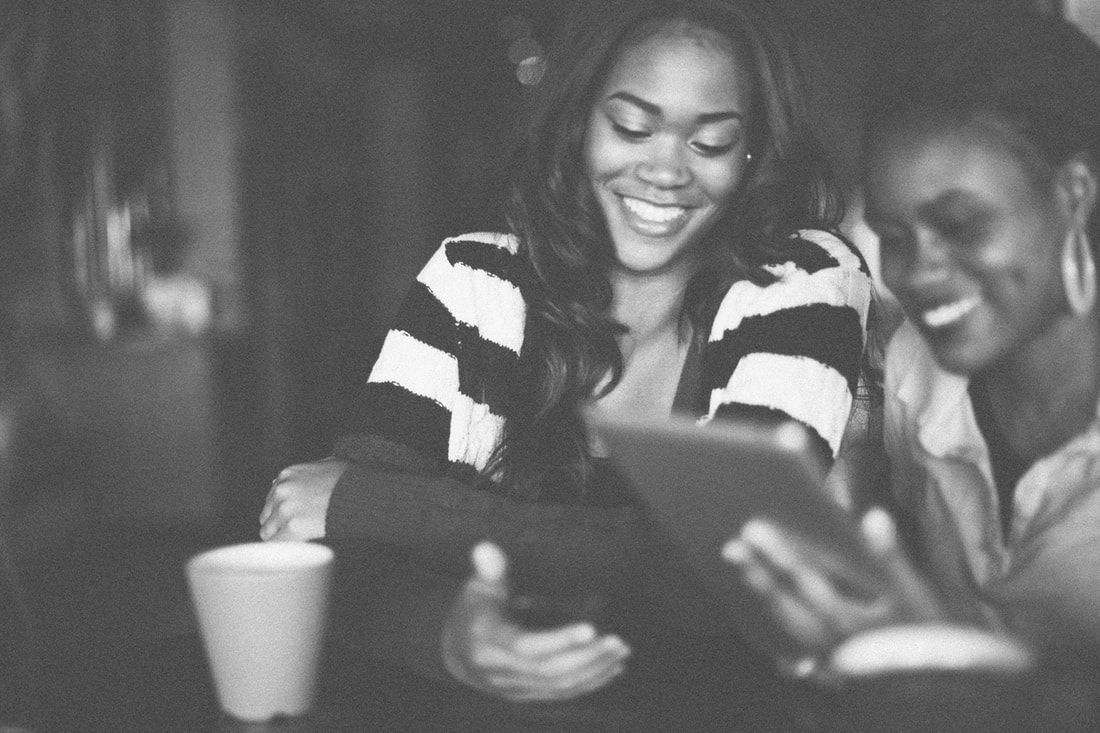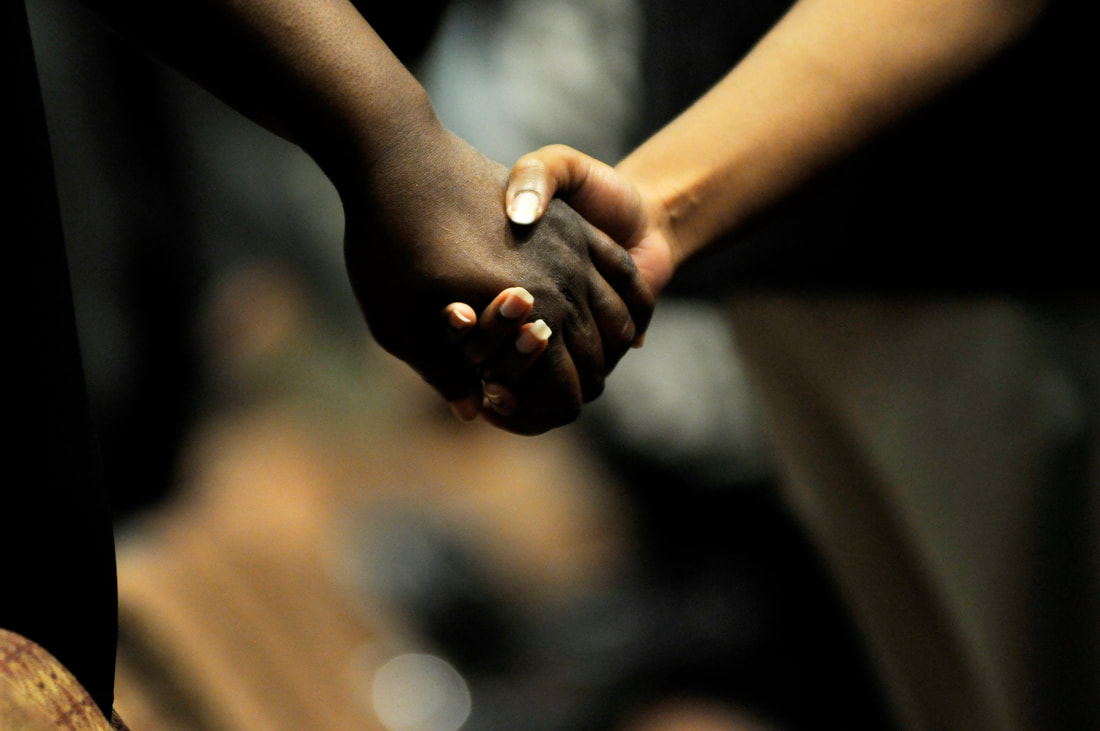Jamie Jean Schneider DommDigital Strategist, Social Media + Big Data, North American Division IntroductionHumanity has been asking existential questions forever. We’re wired for purpose, constantly seeking to answer the big question, “Why?” Although a record-breaking number of believers are leaving brick-and-mortar churches in America, every month, over 100,000 people go on Google and type into the search bar, “Is God Real?” Countless others search for Bible study tools. Our neighbors are asking Siri, not a pastor, “What happens after death?” or profoundly, “What is faith?” The world is going digital, but should the church? The answer is that the gospel should go to all the world, using whatever tools and gifts we have. The eyes of people are on screens, especially the youth. The church must be equipped to go where people’s attention is focused—to be in the world, but not of it. In this free handbook, we’ll demonstrate how to use social media networks for ministry and evangelize to young adults ages 18−30.
Jamie Jean Schneider DommDigital Strategist, Social Media + Big Data, North American Division Only 20% of Americans regularly attend church, and only 2 in 10 millennials consider regular church attendance important. The Church no longer has the option of embracing change or leaving it to the next generation. The time is now; otherwise, we will become irrelevant. Change is never easy, but anything is possible with the Lord (see Matthew 19:26).
People search online for answers to their problems. They turn to the internet for companionship, understanding, information, anonymity, and more. We must be the voice that answers back, online, to share our message of hope and wholeness. Our digital presence may be the only exposure to the Gospel many people receive. We must recognize that the mission field is online, and just as legitimate as traditional evangelism. We need an army of digital evangelists dedicated to carrying the gospel to the digital mission field. Here are 5 steps you can take to become a digital evangelist with resource links:
Jesus sought first to fulfill people’s needs; He then invited them to follow. We can use social media and digital tools to achieve our mission of spreading the gospel and helping people by creating content that focuses on mental, physical, and spiritual needs first. Once this foundation is established, we can invite our audience to “taste and see that the Lord is good” (Psalm 34:8, NIV). When used for digital discipleship and evangelism, this shift in focus is a way we can follow Jesus’ example for everyday ministry to real people. We can use social influence for kingdom building while utilizing modern tools and technologies. For a practical guide to using digital technologies for outreach, community service, growth and evangelism, purchase the North American Division’s Digital Discipleship & Evangelism Guidebook at SDAdata.blog/book. Available from AdventSource. Print, Kindle and ePub versions available. Jamie Jean Schneider DommDigital Strategist, Social Media + Big Data, North American Division Justin KhoeDigital Missionary, "I’m Listening with Justin Khoe; Life. Faith. And the things that matter." INTRODUCTIONPeople come to YouTube for entertainment and education. It’s not an exaggeration to say that video is king! Internet video traffic accounts for 80% of all consumer Internet traffic. YouTube is the second-largest search engine and the second most-visited website in the world. This is where young people spend most of their time online. Creating a YouTube account is very cheap. All you need is a camera and a device to upload from. YouTube is great for communicating ideas quickly and provides a storage place where your content never dies. It can be revisited or reposted as many times as you want. In this free guide, we’ll take you through a step-by-step process for starting a YouTube channel from scratch. We strongly encourage you to take the time to go through this guide completely and review the resources before starting your YouTube channel. Or, if you already have a channel, use this guide to evaluate where changes need to be made. If you’re not yet convinced that your ministry should consider creating a YouTube channel, review the following statistics. YouTube Statistics (May 2020)
If you have the calling to reach young people, YouTube is a must. This 63-page guide will help you determine relevant topics for your target audience and position your videos to maximize reach and watch time. Click the button below to download this free guide. Jamie Jean Schneider DommDigital Strategist, Social Media + Big Data, North American Division It's hard to knock on someone’s door, even if we already know them. In fact, it’s not even socially acceptable nowadays to just show up unexpectedly at someone’s house in case they are busy when we stop by. We must call and schedule a visit first. Add the need for social (physical) distancing, and it becomes clear that the old way of evangelizing can no longer be the primary method. But you don't have to knock on a stranger’s door to share your faith. Nor do you have to create the content. Canvassers are not also the authors of the books they sell. The burden of content creation is not for all of us. Social media allows us to share our faith and engage with our community when it’s most convenient for them. It allows our audience to self-select whether or not they want to engage. Young people spend upwards of 9 to 18+ hours behind a screen each day. That's a lot of opportunity for us to share and reach people anywhere. Excluding periods of sleep and quarantine, how many people are normally home nine hours a day to answer the door? In normal daily life, many people leave the house early and come home late at night. Digital door-knocking is when you share spiritual content on your social media profiles or through messaging and email to create an opportunity for people to engage with you about your faith. The spiritual content can be anything (a picture, text, video, blog, etc.); just be sure to include with it a personalized message about how it impacted you. Your friends and followers can scroll past it or choose to engage when it’s convenient for them. Given that a lot of people could be stuck at home with extra time on their hands because of COVID-19 or a future crisis, social media may be their main source of entertainment and connection. There’s a lot of opportunity right now for us to share and reach people everywhere using digital technologies. Success can no longer be measured only by counting people in a building but, rather, we must consider whether or not we’re building a kingdom. World-of-mouth opportunities online Word-of-mouth is still the strongest marketing mechanism for getting the word out about a product or cause. People always trust the opinion of their friends and family over what a brand says about itself. This is why reviews and testimonies are so powerful. We participate in word-of-mouth marketing every time we share about a product or experience with others. We might share in person, but word-of-mouth marketing often takes place on social media and through messaging applications and texting, etc. We do this constantly when it comes to our other interests and don’t even realize it. In terms of sharing the gospel, this just means doing the thing you do all the time online but doing it for the kingdom. In other words, be intentional with what you share. Here are some digital ways individuals can distribute our messages:
Leverage social influence through podsCreate a culture of sharing and content engagement within your church community. Nearly everyone is on social media. Even if you have an older congregation, a good many of them are likely on Facebook and have an email address. Don't assume that they are not; ask and find out what platforms they use. Social influence can be both analog and digital. Churches do well with analog distribution (printed flyers for example); however, we need to start leveraging the digital social influence of our members. Even in a small church with 50 congregants, if half were on social media and were connected to just 50 people within the community (outside of the congregation), that's a potential reach of 1,250 people. This is a low estimate, but you get the idea. Train your membership to function like a social media “pod.” A “pod” is a group used to increase engagement on social media platforms like Instagram and Facebook but can apply even to email. Members of a pod agree to comment, like, and share each other’s content or the content of a particular entity such as a church or ministry. Teach your membership to engage and share your church content on a weekly basis as a form of evangelism/outreach. Pod commitments vary but typically fall into three categories:
Be sure to:
Holiday test case My local church is predominantly older, and we have around 200 members—not a mega church by any standard. For our holiday programs and special events, the leadership asks me to lead promotion. Beyond targeting the community with social advertising, I also spend a lot of time rallying the membership to hand out flyers, forward emails, share on social media, text people, etc. This is new for them and out of their comfort zone, but we are a close-knit community, and our members really do seek to help each other.
At the end of our six-week campaign for our annual Christmas play, 393 tickets had been reserved in advance, and on the day of the event, we packed the house with around 500 in attendance. Now, the DC-Metropolitan area has a lot of holiday opportunities, so people did not have to choose us. By and large, most people who reserved tickets online said they had heard about the event from a friend or family member, via email or social media. Word-of-mouth out-performed paid social advertising. For our previous event at Easter, by contrast, with no promotion strategy and much less competition in the area, only 100 tickets were reserved in advance. After the Christmas play, we sent a survey follow-up to gather feedback to better understand our audience and let them know that we valued their opinion. This allowed us to understand how many non-Adventists attended the program. In this case, 20% of survey respondents were not Adventists. It also gave us an opportunity for service by adding this question: Is there anything we can help you with? Let us know how we can bless you, and please provide your contact information. Here is an example of how with the right coaching, even an older congregation can realize their untapped potential for helping their church better reach the local community through increased awareness. This example served as a test run and, since then, all the tickets for our special programs have been reserved in advance of the event. This example had immediate results, but having a congregation that consistently engages in digital door-knocking would have a long-tail effect that we may not fully appreciate this side of heaven. Using this model, our messages of hope and wholeness could be spread to every corner of the digital space and, while not everyone is able to walk through the door of a church, they will be able to connect with God. Jamie Jean Schneider DommDigital Strategist, Social Media + Big Data, North American Division You might be tempted to think that we will return to normal in a few weeks or a few months. We will return to normal, but it will be a new normal. – Chuck Scroggins In the weeks since COVID-19 shut down churches across America and the world, I’ve seen an unprecedented amount of creativity and innovation from churches and ministry leaders. What was previously considered impossible or unimportant has become both possible and important overnight. For many, such as the physically disabled and those unable to attend church in person for other reasons, these changes are welcome and long-anticipated accommodations— accommodations that should have been offered when the technology first became available. Our hesitancy to embrace change left many behind and isolated long before COVID-19. It’s unfortunate that it took a pandemic to motivate the Church to embrace digital technologies, but here we are. Change is not only possible but also necessary. Now, we must figure out together what the “new Church” will look like. When the dust settles, society will return to a new normal with new habits and expectations. The changes we make now will set us up for success or failure in the years to come. First and foremost, online church must be different. It can’t be just a streamed program of a few people in an otherwise empty sanctuary. Church is not a program or a building, it’s a faith community sharing their relationship with God and taking action to improve the well-being of others. We must consider the experience of the individuals participating and think empathically about what they expect and need. Beyond meeting the spiritual needs of church members, digital technologies can be used to mobilize a congregation for community and service in the digital space. What starts in the digital space is not necessarily nor ultimately confined to the digital space. These tools and technologies can create impact in the real world and be leveraged to meet the real physical needs of the community. We can still be the hands of Christ reaching out to help others in their need; it will just be in a way that is different from what we’re currently comfortable with. We must think creatively about how the “church experience” can be translated to the digital space. This will take the creativity and innovation of everyone, experimenting and trying new things to figure out what works best. It will be different for each congregation and community. We are now in a period of rapid development, innovation, and customization. It’s an exciting time, and I am personally energized seeing God working through His church during this time of change. This also means that our choice of our “home” church is no longer restricted by physical location. Churches that adapt well will draw members from everywhere to their online church experience. The barriers to entry that once prevented people from attending in person have been stripped away. Those who were previously at a disadvantage are now on equal footing with the rest of the community. When COVID-19 is all over, the structures we are now implementing should stay in place to continue to reach those we’ve previously left behind. Besides, we know the scriptures: this may be only the beginning of such troubles. There will be more pestilence and an ongoing need for digital technology. We must stop thinking of this as a temporary shift and realize technology’s long-term potential. You may be asking: How can we build community online? How can we make online church special? What are the best practices for online church? As we continue to adapt and modify our worship and service experiences to address these questions, here are 15 “best practices” to consider:
We want our church to come back stronger and more unified from this experience. Normally, we talk about how digital technologies are a powerful means to scale up traditional ministry and evangelism, but COVID-19 has pushed the need for digital technology to become our priority. We’ve created and curated several resources we think you will find useful to help migrate your worship service and help you build an online community for your church. Visit SDAdata.org/goingdigitalcovid19 to get started. Click here to learn more about digital evangelism and discipleship. Jamie Jean Schneider DommDigital Strategist, Social Media + Big Data, North American Division The weekend that the world woke up to the COVID-19 pandemic saw a wave of closings and radical changes to our daily lives never before seen in the history of mankind. The same weekend brought a stunning amount of anti-Christian rhetoric online. I am an administrator for over 50 ministry social media accounts, and my notifications were filled with hateful comments, aggressively mocking us and our collective faith and, in some cases, even blaming Christians and our “foolish” thinking through some convoluted logic that I didn’t bother to try to understand. What shook me the most was that this behavior was foretold in the Bible. It wasn’t that I didn’t believe the scriptures, but in my mind, it was always for some far future time. I certainly wasn’t expecting to experience this first-hand on March 15, 2020. Know this first of all, that in the last days mockers will come with their mocking, following after their own lusts, and saying, "Where is the promise of His coming? For ever since the fathers fell asleep, all continues just as it was from the beginning of creation." (2 Peter 3:3–4) One repeated phrase stuck out for me as I combed through the comments, deleting them and banning hostile people in an effort to protect our faith communities from continued harassment in this time of crisis. I lost count of how many times I read, “Where is your God now?” Over and over again, I saw the same comment, sometimes accompanied by rude pictures mocking our Savior. The hostility from these armchair antagonists was deeply concerning. But the question remains, “Where is my God now?” In the days that followed, I began to see an immense amount of creativity and innovation emerging from the Church as pastors and ministry leaders began to adapt. I realized that the answer to the mockers’ question is that my God is on the move, while we’re stuck at home. When fleeing persecution, the early church took the gospel to new regions out of necessity. Two thousand years later, we find ourselves in a similar situation. We must now take the gospel message to the digital mission field and spread our message of hope and wholeness when it is needed most.
We know that God causes all things to work together for good to those who love God, to those who are called according to His purpose (Romans 8:28). In Daniel 3, God didn’t deliver the three Hebrew boys from the fire; He delivered them IN the fire to act as witnesses to King Nebuchadnezzar and his kingdom. While in the fire, the three boys came near to God and walked with the preincarnate Christ. Their experience served a greater purpose and testifies to us even today. God didn’t create the fire, the persecution, or the pestilence, but He can steer His church in this crisis to accomplish His will for the salvation of souls. He can and will manifest His power so that the living may know that the Most High rules over mankind (Daniel 4:17). It appears that the world is falling apart, and people are paralyzed with fear. Where is God now? God is on the move in every church and in the heart of every digital missionary who is stepping out in faith to accomplish our mission. He doesn’t need us to fulfill His work, but He invites us to work alongside the Holy Spirit. For digital advocates like me, this is a long-awaited and surprising answer to prayer. It’s unfortunate that it took a pandemic to motivate the Church to embrace digital technologies on a large scale. For people who know that the end is coming, we have dragged our feet too long. COVID-19 is a kick in our complacency and a wake-up call to jump on the digital bandwagon. We have had access to these tools for over a decade, and I believe the Holy Spirit has been pleading with us to use them. Previously, many of us advocated for rethinking church in the digital age to meet the needs and expectations of the younger generations. Our voices were often dismissed as too extreme. Overnight the landscape changed; now we are forced to rethink church without the building for everyone. Perhaps this is the point. We’ve gotten too accustomed to thinking of church as a place to go to for a few hours a week, and not as people in action, striving to improve the well-being of others and spreading the good news. Now is the time to focus on the future and on what the Church can become. Until now, those of us advocating for digital technologies have been up against systems and traditions that have been difficult to change. However, these structures and mindsets are quickly becoming obsolete in this new reality. The current generation no longer has the option of embracing change or leaving it to the next generation. The time is now; otherwise, we will become irrelevant. Change is never easy, but anything is possible with the Lord. This shock to our society is nothing to fear; God is always with us, and we must continue to embrace this new reality to continue the work. Make no mistake, we are never going back—COVID-19 will fundamentally change how businesses, organizations, and society functions. Everyone across the generations will be forced to utilize digital tools for productivity and daily life. When this is over, and we can once again embrace our brothers and sisters, we will all have to tighten our belts from the economic fallout. Travel will be a luxury, while the positive impact on the environment may solidify many of our behavioral changes. Only God knows for sure how this will change the world, but the Bible tells us that this is only the beginning of the birth pains; there is more pestilence and tribulation to come. We may never fully be able to leave physical distancing behind, but time spent in isolation can be filled with seeking for truth and assurance in our messages of hope and wholeness. People will continue to turn to the Internet for companionship, understanding, information, anonymity, and more. We must be the voice that answers back online in these times of crisis and beyond. COVID-19 is not the end, but it is a warning—a warning to God’s church to wake up and get ready. Jesus is coming, and we haven’t finished the work. This crisis is an opportunity to prepare and mobilize. It’s time for a generation of digital evangelists and disciples to carry the Gospel to the digital mission field, which may well be the final mission field. This is our generation’s Great Commission. Jamie Jean Schneider Domm Digital Strategist, Social Media + Big Data, North American Division He who is careless and heedless in uttering words or in writing words for Long before audio-visual equipment was invented, Ellen White knew how to do the figurative mic drop better than anyone. This quote is a powerful and relevant reminder of the solemn task we have been charged with. I encourage everyone who is on social media, especially digital missionaries, to read her Counsels to Writers and Editors. Social media is the ultimate equalizer. It gives a voice and a platform to anyone willing to engage. – Amy Jo Martin Social media has eased entry into the world of telling stories, sharing ideas, and expressing thoughts to a wide audience. It used to be that if you wanted to tell your story to a broad audience, you had to buy your way in through costly traditional media. Times have changed; we are all writers and publishers now. But with this ability comes responsibility. Social media, in its essence, is people connecting with people to create a collective human story. We all want to be heard, and we all now have a platform for public speaking. You can have hundreds, thousands, even millions of people viewing your messages. But, as so often is the case, the person we need to set boundaries with is ourselves. Your personal social media is a great opportunity to share your story and contribute to the collective conversation. It can serve as a powerful witnessing tool, revealing what God is accomplishing through you and your work. But… Would someone know you are a Christian based on your social media? I once listened to a powerful sermon in which the speaker asked, “If you were pulled into court today, is there enough evidence in your life to convict you of being a Christian?” Well, what evidence does your social media provide? Is your use of social media driving people away from the Church or toward Christ? Think about it. Social media is public by nature and has blurred the lines between your work for the Church and your personal life. This can be a good thing. Follow principles of responsible use and be a living testimony to others. Be a light among the quagmire of negativity online. Let your light shine before men in such a way that they may see your good works, and glorify your Father who is in heaven. – Matthew 5:16 Every opportunity to share is an opportunity to either advance or hinder the kingdom of God. People should use social media; it is a powerful tool. After all, the appeal of social media is that it reflects a basic human need, and that need is to connect and share. As digital disciples, that means connecting with each other and God as well as sharing the gospel. It is likely that you have friends or followers on social media who are not Christians or who are questioning and struggling with their faith. As a member of the Church, you are always representing the Church even if you are not actively engaged in digital evangelism. This is especially true for pastors and others in leaderships roles. It is of vital importance that we maintain a high standard of ethics, striving to always be honest, professional, and kind. This means always verifying questionable content with credible sources before sharing, honoring the privacy of others, respecting intellectual property rights, and never releasing confidential information. However, you may share official statements from Church leadership. Your posts can have a much greater impact and reach than you imagine. We recognize and value diversity of opinion within our community, but as an employee or member, your followers may confuse your opinion with the official position of the Church. While this is most likely not your intention, be mindful to:
How many people are you willing to drive out of the Church to make a point or to “win” your argument? Public figures have the potential to magnify division and take thousands out of the Church. As individuals, we may discourage someone from even considering Christianity. We talk about a life lived as a reflection of Christ but turn into devils on social media. People say things online that they would never dare to say in person, and then wonder why their ministry efforts are not bearing fruit. We were all taught in primary school to T.H.I.N.K. before we speak. It is not enough for something to be True; it must also be Helpful, Inspiring, Necessary, and Kind. This is especially true in online communication. Because of the power social media can have, it’s crucial that we consider the effects our content will have on our audience. Both our negativity and our positivity grow exponentially as they are spread by our audience and friends online. When it comes to church, we can create a community of people that attack or a community of people that heal. – Kaleb Eisele, Humans of Adventism We absolutely respect and value different perspectives among our members and ministry leaders. But as representatives of the Church, we must not use our public speaking platforms as a sounding board for the problems we see in the Church, in leadership, and in our country. We are a family; let’s resolve our internal issues privately. It would be considered obscene to go knocking on doors and to begin your evangelistic effort by lambasting the very Church you are asking people to join. So why do it online? We must protect our Church family and frame all of our digital communications with the salvation of others in mind. Social media is a powerful tool for sharing the gospel; let’s use it wisely and err on the side of caution. The power and efficiency of our work depend largely on the character of the literature [message] that comes from our presses [social media profiles]. Therefore, great care should be exercised in the choice and preparation of the matter that is to go to the world. The greatest caution and discrimination are needed. Our energies should be devoted to the publication of literature [posts] of the purest quality and the most elevating character. Our periodicals [blogs, videos, and updates] must go forth laden with truth that has a vital, spiritual interest for the people. Freedom of speech does not mean freedom from consequences. Carelessness in speech can and will inhibit our ability to accomplish our mission. When we turn people away from the Church, we are not only working against ourselves, we are working against God. You can also get your ministry or self in legal trouble. If you work for the Church, you may endanger your job and reputation. This can be avoided by using discretion and focusing on the positive, such as what God is accomplishing through your church or ministry. Let’s not fall into the trap of using the negative and sensational to get attention online when God calls us to focus on what is good and holy. Finally, brothers, whatever is true, whatever is noble, whatever is right, whatever is lovely, whatever is admirable―if anything is excellent or praiseworthy, think about such things. – Philippians 4:8 We all have the same goal. I truly believe that social media is a vital tool for accomplishing our mission in the 21st century. Young people are leaving the Church at a startling rate. They spend up to 18 hours a day behind a screen, and nine hours of that time is spent on social media. What messages are you sending them? We must take the gospel where they are, and not where we want them to be. But when our actions and our speech contradict each other, we only have ourselves to blame for the rising egression. Let’s work together to get the job done and go home. And this gospel of the kingdom will be preached in all the world as a witness to all the nations, and then the end will come. – Matthew 24:14 Jamie Jean Schneider Domm Digital Strategist, Social Media + Big Data, North American Division  Content creation, engagement, and distribution are not limited to the official church brand and accounts. Make it a point to reach out to young people and let them know that their talents in this area are highly valued even if they are not part of the core team. Some people just need permission and a little mentorship to realize their talents and passion for personal ministry. Everyone has social influence through texting, messenger applications, email, and social media. Encourage and inspire them to use it to build God's kingdom. The two primary roles in which digital disciples can serve are as engagers and distributors. For this reason, I have decided to unpack the role of digital disciples here in the guide, in-between these two sections of the digital discipleship and evangelism model. The Bible tells us to become and make disciples. God calls us all to serve in unique ways. Ellen White encourages us to: Let every worker in the Master’s vineyard, study, plan, devise methods, to reach the people where they are. We must do something out of the common course of things. We must arrest the attention. We must be deadly in earnest. We are on the very verge of times of trouble and perplexities that are scarcely dreamed of. – Ellen White, Letter 20, 1893 Identify people in your church who can be digital disciples, all on their own, as a means to further the mission of your church. This allows and empowers members to engage in ministry and discipleship in ways that aligns with their passion, spiritual gifts, tools of preference, and personal style. There is a spiritual void online because we are not doing enough individually as members or collectively as a Church. The mission field is wide open, it’s our duty to share the gospel through the tools available to us. The Great Commission given to us by Jesus Christ states, “Go, therefore, and make disciples of all the nations” (Matthew 28:19). An easy and free way to reach the nations lies in the palms of our hands. When we hesitate to make the gospel message more available, we allow our own human weaknesses and fears to get in the way of our mission. How can we justify this resistance to boldly declaring our faith online? We live in an era of religious freedom with minimal persecution in North America (in contrast to what is happening in other parts of the world). However, the predominant perception among the Church body is that evangelism is an event run exclusively by a specific set of people. In Exodus 4:2, God asks Moses “What is in your hand?” and tells him to lead the children of Israel to the promised land. To Moses, his staff is simply a tool for directing sheep, but with God’s direction, it becomes an instrument through which miracles are performed. If God spoke to each of us today, we would answer, “a phone,” a “laptop,” or an “iPad.” Most of us have a smart phone that can be used either for distraction or for positive impact. The responsibility of every disciple is to utilize every available resource for God so at the end of the age, when we face our Master, we will hear, “Well done, good and faithful servant!...” (Matthew 25:23). We must commit to work diligently online to share present truth, regardless of who we are and what our official role may be in the Church. Tips and Ideas for Individual Digital Disciples, |
Archives
August 2020
Categories
All
|
- Home
- BLOG
-
RESOURCES
-
RESOURCE MENU
>
- ADVENTIST IDENTITY GUIDELINES
- BIG DATA RESOURCES
- BRANDING, IMAGE & DESIGN RESOURCES
- CHURCH/MINISTRY SPECIFIC RESOURCES
- COPYRIGHT & TRADEMARK BASICS
- COURSES
- EMAIL RESOURCES
- GUIDANCE FOR HIRING SOCIAL MEDIA POSITIONS
- PODCASTS
- REPORTS & CASE STUDIES
- SOCIAL MEDIA RESOURCES
- (SOCIAL) VIDEO RESOURCES >
- TEXTING 4 CHURCHES
- TRACKING & ANALTYICS
- WATCH VIDEOS & TUTORIALS
- WEBSITE TIPS
- SOCIAL MEDIA GUIDELINES
-
RESOURCE MENU
>
- SEO
- Digital Discipleship & Evangelism
- COVID-19 RESOURCES
- eNEWSLETTER











 RSS Feed
RSS Feed